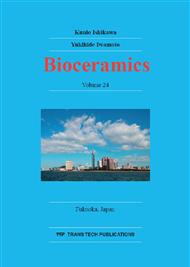p.407
p.413
p.417
p.421
p.426
p.430
p.436
p.441
p.447
Fabrication of Composites from Apatite and Chemically Synthesized Collagen
Abstract:
Chemically synthesized collagen with triple helix structure similar to natural collagen has been developed as a safe biomaterial. If the chemically synthesized collagen is deposited with apatite, they are expected for novel bone substitutes having bioactivity and bioresorbability. Although apatite formation on the chemically synthesized collagen has been examined, highly supersaturated condition such as 1.5SBF with ion concentration 1.5 times those of simulated body fluid (SBF) is needed to achieve apatite formation. In the present study, we intended acceleration on the apatite formation on the chemically synthesized collagen by immobilization with polyglutamic acid (PGA). PGA is known as biodegradable and biocompatible polypeptide having excellent apatite-forming ability. We examined effects of the immobilization procedure on mineralization behavior in SBF. At first, PGA was immobilized on porous sponges of chemically synthesized collagen in aqueous solutions containing PGA and CaCl2. As a result, not only apatite but also calcite-type CaCO3 was deposited on the specimens in SBF. The calcite formation was occurred during the treatment with PGA solution. pH of the solution was adjusted to 7 by NaOH solution in order to avoid dissolution of the collagen. During this procedure, Ca (OH)2 would be precipitated by locally increase in pH of the solution and converted into the calcite. When the PGA solution treatment was shortened so as to prevent the calcite formation, single phase of the apatite was formed in SBF. The present results indicate that crystalline phase deposited on the chemically synthesized collagen can be controlled by fabrication procedure, and provide fundamental design of composites containing apatite and chemically synthesized collagen useful for bone regeneration.
Info:
Periodical:
Pages:
426-429
Citation:
Online since:
November 2012
Authors:
Price:
Сopyright:
© 2013 Trans Tech Publications Ltd. All Rights Reserved
Share:
Citation:


